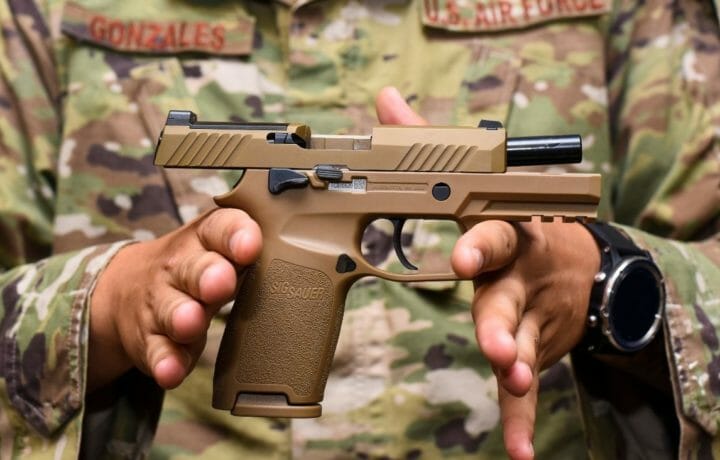Just over a year ago, the U.S. Air Force’s combat arms units began receiving the new and improved 9mm M18 semi-automatic pistols, which were produced by Sig Sauer. The new handguns began to replace the Beretta M9 pistols that had been used by the service since 1985.
Beginning in June 2020, the Air Force Life Cycle Management Center’s Small Arms Program Office acquired approximately 125,000 M18s from Sig Sauer for $22.1 million, and started to make the weapons available to Air Force organizations that have a handgun requirement.
“The Air Force bought the M9s back in the 1980s, and the design has not really changed since then,” Merrill Adkison, small arms program office senior logistics manager, said at the time of the acquisition. “M9s are larger, heavier, all-metal pistols; whereas M18s are lighter polymer pistols with a more consistent trigger pull and adjustable grips for large and small hands.”
In addition to a smaller and lighter handgun, the M18 also was reported to have cost the Air Force about one-third of what it would have cost to buy a new M9 Beretta.
Military Adoption
The M18 is the smaller version – the smaller-sized carry model – of the full-size M17, which was adopted by the United States Armed Forces via the United States Army’s XM17 Modular Handgun System competition. The Sig Sauer P320 model was officially selected in January 2017 – becoming the M17 – while the 101st Airborne Division became the first unit to receive the new handgun.
The rest of the Armed Forces followed suit, and it became the standard sidearm for the entire U.S. military. The services had announced plans to procure up to 421,000 weapons in total, with the bulk going to the Army. The Air Force and Navy primarily adopted the M18 compact version.
Additionally, while the U.S. Coast Guard had also announced that it would adopt the M17/18 as its standard sidearm, instead last September the service announced that it would acquire the Glock 19 handguns via a Department of Homeland Security (DHS) procurement.
Modular Handgun
The P320 platform had numerous features that the U.S. Army found to be appealing, including the fact that it was designed to be ambidextrous in handling, while sporting a catch lever on both sides of the slide. It also features a user-reversible magazine, while other operating controls are designed to be easily operated from either side.
The handgun was also designed to be field stripped without the need for tools, while it can also be field stripped without depressing the trigger – which also prevents negligent discharge of the weapon.
The M17/18 are chambered in the widely used 9x19mm Parabellum round, but the contract with Sig Sauer allows the military to procure the proposed XM1152 Full Metal Jacket and XM1153 Special Purpose ammunition. The M17 can be used with either standard 17-round or extended 21-round magazines. The compact M18 uses the same frame as the M17, but with a size-medium grip and a 3.9-inch barrel and shorter slide.
The Compact Airmen Pistol
There are numerous factors that supported the Air Force’s decision to adopt the M18 – notably that it is lighter than the M9, and has a barrel that is an inch shorter. Now it seems the service is looking to further shrink the sidearms.
Task & Purpose reported this week that the Air Force is looking to further shrink the pistol, making it easier to conceal. The service has called for security forces airmen and law enforcement civilians to be allowed to carry concealed weapons off-duty while on an Air Force base, and a smaller M18 would certainly fit such a use perfectly.
While neither the firearms manufacturer nor the Air Force actually confirmed there is a plan in place for a smaller sidearm, a bid was posted last month on the U.S. government’s contracting website.
The DoD was listed as the department/ind. agency, while the sub-tier was listed as the Department of the Air Force, and AFMC (Air Force Material Command) as the major command.
“The government is seeking a source for a quantity of 3,015 each modification kits for the conversion of the M18 Modular Handgun System (MHS) to a Sub-Compact design to meet concealed carry requirements. The required modification kit is SIG SAUER part number WKIT-320XC-9-BSS-R2-MHX,” read the description.
Sig Sauer in the NGSW Running
It is unclear at this point if the adoption of the M17/18 will give Sig Sauer – the U.S./German firearms manufacturer – any advantage in the U.S. Army’s current Next Generation Squad Weapon competition, which will determine the replacement for both the M4 carbine and M249 Squad Automatic Weapon (SAW).
Sig Sauer is one of three companies – along with General Dynamics and Textron Systems – to be selected for the final round of testing. The Sig Sauer design is actually two versions, each reportedly based off its MCX firearms line. Each features a folding stock capability; the machine gun version includes a 16-inch barrel while the rifle version offers 13-inch barrel. The overall design of Sig Sauer’s firearm is also similar enough to the legacy systems that soldiers shouldn’t need additional training.
The Army will likely make its decision on the NGSW by the end of this year.




